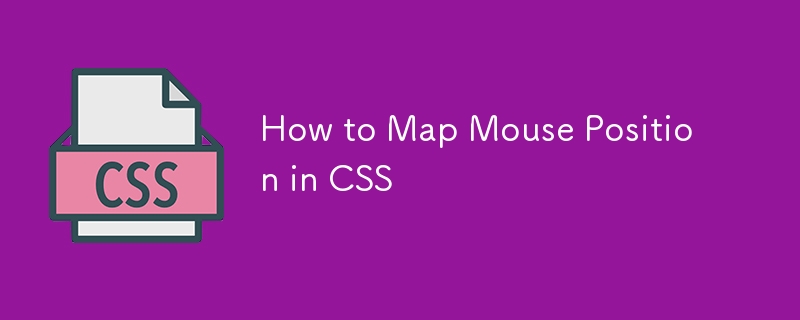How to Map Mouse Position in CSS

This article demonstrates a pure CSS technique to capture mouse position and map it to custom CSS properties: --positionX and --positionY. While JavaScript offers similar capabilities, this method avoids JavaScript entirely, achieving effects like click-and-drag interactions using only CSS.
The core concept involves creating an invisible grid and leveraging the :hover pseudo-class. Each grid cell triggers a change in the custom properties, reflecting the mouse's X and Y coordinates. This allows for dynamic control of various CSS properties.
Setup:
The initial HTML includes a wrapper <div> with a <code>.content class, spanning the body's width and height. This container holds the element to be manipulated (e.g., a .square element) and defines the custom properties --positionX and --positionY.
The Grid:
A 10x10 grid is created using CSS Grid. The grid size is adjustable, but larger grids increase accuracy at the cost of performance. Crucially, the grid cells (.cell elements) precede the .content div in the HTML to leverage CSS cascading rules effectively.
Positioning Cells:
The .cell elements are positioned using display: grid. A temporary border aids visualization during development. z-index: 2 ensures the cells are layered above the .content.
Adding Values:
The core logic involves assigning values to --positionX and --positionY based on which grid cell is hovered. A Sass @for loop iterates through the cells, calculating and applying the appropriate values using :nth-child() selectors.
The X-axis mapping uses :nth-child(10n #{$i 1}) to select columns, while the Y-axis uses :nth-child(n #{10 * $i 1}):nth-child(-n #{10 * ($i 1)}) to select rows.
Handling Custom Properties:
The custom properties are then used within calc() functions to dynamically control the .square element's width and height. For instance:
1 2 3 4 |
|
An alternative method directly sets width and height values within the Sass loop, offering more flexibility for complex calculations.
Further Applications:
The technique extends beyond width and height manipulation. It can control top, left, transform, background-position, colors, and pseudo-element content, opening diverse creative possibilities. The article encourages readers to experiment and share their creations.
The above is the detailed content of How to Map Mouse Position in CSS. For more information, please follow other related articles on the PHP Chinese website!

Hot AI Tools

Undresser.AI Undress
AI-powered app for creating realistic nude photos

AI Clothes Remover
Online AI tool for removing clothes from photos.

Undress AI Tool
Undress images for free

Clothoff.io
AI clothes remover

Video Face Swap
Swap faces in any video effortlessly with our completely free AI face swap tool!

Hot Article

Hot Tools

Notepad++7.3.1
Easy-to-use and free code editor

SublimeText3 Chinese version
Chinese version, very easy to use

Zend Studio 13.0.1
Powerful PHP integrated development environment

Dreamweaver CS6
Visual web development tools

SublimeText3 Mac version
God-level code editing software (SublimeText3)

Hot Topics
 1664
1664
 14
14
 1423
1423
 52
52
 1321
1321
 25
25
 1269
1269
 29
29
 1249
1249
 24
24
 A Proof of Concept for Making Sass Faster
Apr 16, 2025 am 10:38 AM
A Proof of Concept for Making Sass Faster
Apr 16, 2025 am 10:38 AM
At the start of a new project, Sass compilation happens in the blink of an eye. This feels great, especially when it’s paired with Browsersync, which reloads
 A Comparison of Static Form Providers
Apr 16, 2025 am 11:20 AM
A Comparison of Static Form Providers
Apr 16, 2025 am 11:20 AM
Let’s attempt to coin a term here: "Static Form Provider." You bring your HTML
 Weekly Platform News: HTML Loading Attribute, the Main ARIA Specifications, and Moving from iFrame to Shadow DOM
Apr 17, 2025 am 10:55 AM
Weekly Platform News: HTML Loading Attribute, the Main ARIA Specifications, and Moving from iFrame to Shadow DOM
Apr 17, 2025 am 10:55 AM
In this week's roundup of platform news, Chrome introduces a new attribute for loading, accessibility specifications for web developers, and the BBC moves
 The Deal with the Section Element
Apr 12, 2025 am 11:39 AM
The Deal with the Section Element
Apr 12, 2025 am 11:39 AM
Two articles published the exact same day:
 Multi-Thumb Sliders: General Case
Apr 12, 2025 am 10:52 AM
Multi-Thumb Sliders: General Case
Apr 12, 2025 am 10:52 AM
The first part of this two-part series detailed how we can get a two-thumb slider. Now we'll look at a general multi-thumb case, but with a different and
 Some Hands-On with the HTML Dialog Element
Apr 16, 2025 am 11:33 AM
Some Hands-On with the HTML Dialog Element
Apr 16, 2025 am 11:33 AM
This is me looking at the HTML element for the first time. I've been aware of it for a while, but haven't taken it for a spin yet. It has some pretty cool and
 How We Tagged Google Fonts and Created goofonts.com
Apr 12, 2025 pm 12:02 PM
How We Tagged Google Fonts and Created goofonts.com
Apr 12, 2025 pm 12:02 PM
GooFonts is a side project signed by a developer-wife and a designer-husband, both of them big fans of typography. We’ve been tagging Google
 It's All In the Head: Managing the Document Head of a React Powered Site With React Helmet
Apr 15, 2025 am 11:01 AM
It's All In the Head: Managing the Document Head of a React Powered Site With React Helmet
Apr 15, 2025 am 11:01 AM
The document head might not be the most glamorous part of a website, but what goes into it is arguably just as important to the success of your website as its




